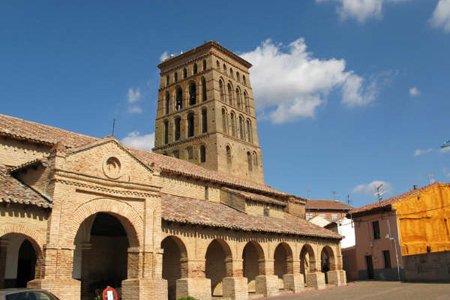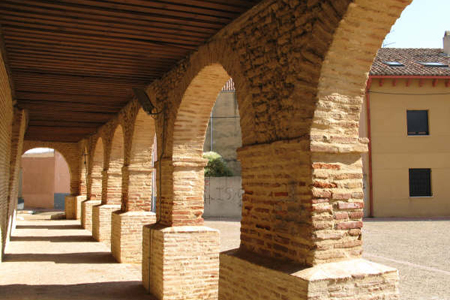 |
||||||||||
 |
||||||||||
|
1515: San Lorenzo, Sahagún, León, Spain Mystery Worshipper: Augustine the Aleut. The church: San Lorenzo, Sahagún, León, Spain. Denomination: Roman Catholic, Diocese of León. The building: Pale stone with a well-arched porch looking out onto a dusty sunny square. Most scholars seem to think that it dates from the 13th century, and one chronicler refers to archers sniping from the tower during a riot in 1253. The stonework, the square tower, and the arches all suggest that it is another product of Mudéjar (Muslims who stayed behind in Christian Spain after the reconquest) craftsmen. There is a 1730 baroque retablo, thankfully not too horrific. This Canadian pilgrim was pleased to see a side altar dedicated to his country's patron, John the Baptist, and puzzled by a statue of St Lucy holding the customary plate on which rested her eyeballs, like a waitress serving up some very horrid tapas. The church: San Lorenzo, or St Lawrence, was ordained a deacon in Rome in the year 257. He was one of the church's first archivists and as such is venerated as the patron saint of librarians. Legend has it that among the treasures entrusted to him was the Holy Grail – although stories abound concerning the disposition of the Grail, St Augustine for one apparently believed that Lorenzo used it to administer the wine at mass. Lorenzo was eventually ordered to return the riches entrusted to him to the prefect of Rome, but instead distributed them to the poor, an act which led in 258 to his martyrdom by being grilled alive – a fate which wags have suggested qualifies him as the patron saint of barbeques. In art he is sometimes depicted holding a sack of coins, sometimes standing in front of a heap of burning coals covered by a gridiron. The neighbourhood: The church opens up into a hot and dusty square at the north end of the older town, not far from the railway tracks, right by where the former Jewish and Muslim quarters met. Sahagún has always been a cosmopolitan town, its 1085 charter providing for Jews, Moors, Burgundians and Englishmen, among others. However, two mini-Holocausts destroyed the Jewish community well before the general expulsion of 1492. This is not a rich part of town, and there are some small market shops nearby. Oddly, there are no cafés on the square. The cast: The priest, in his 60s, was probably the rector, Don Jenaro Barreales Barreales. The date & time: 5 October 2007, 8.00pm. What was the name of the service? Evening Mass. How full was the building? Potentially holding 200 or so, there were about 30 in the congregation, including an Australian couple from Melbourne, and an ascetic young Spaniard, tall and with a short-clipped beard, whom I had passed on the camino earlier that day. Did anyone welcome you personally? The Spanish don't seem to have greeters, but I received friendly nods and smiles as I found myself a pew. This is a major stop on the pilgrimage route, and the church of the Trinity has been made into a pilgrims' hostel, so they are used to us. Was your pew comfortable? It was solid with a broad wooden seat and a low back, with plenty of space between my seat and the row ahead, so I didn't feel cramped. I had the impression that the carpenters had spent many hours in churches and were solicitous of worshippers. How would you describe the pre-service atmosphere? One of the women in the congregation stood near the front and led parishioners in saying the Rosary. What were the exact opening words of the service? En el nombre del Padre, y del Hijo, y del Espíritu Santo. On this one, there are never any surprises in Spain. What books did the congregation use during the service? None. What musical instruments were played? As it was a weeknight mass, there were no instruments, but during the communion several women sang a hymn I did not recognise. Did anything distract you? Not really. It had been a long and hot 31km trek that day, and I was just enjoying the sensation of not moving, and being out of the sun. Was the worship stiff-upper-lip, happy clappy, or what? By this time I was becoming accustomed to the relaxed formality of RC practice in northern Spain. Everyone seemed at home with what was being done.  Exactly how long was the sermon? 5 minutes. On a scale of 1-10, how good was the preacher? 8 – I think I understood most of it. His tone was conversational, and there was what appeared to be a deprecating joke referring to his baldness, which reaped hearty chortles from worshippers rather than the polite chuckle that preachers normally get. In a nutshell, what was the sermon about? He spoke of how the immigrants who came there at harvest-time learned about Christianity by the way Christians behaved, and how we must be fair and friendly and open with our hearts. Our Lady was mentioned frequently. Which part of the service was like being in heaven? It was cool and restful after a long day. I had a feeling that we were all there to be refreshed and to get some stillness. But that might have been me extrapolating. And which part was like being in... er... the other place? Nothing, really, although even at my advanced age, I might have been the youngest person there, aside from the Spanish pilgrim. What happened when you hung around after the service looking lost? As the service ended, the priest motioned the pilgrims to come up. The Spaniard walked up as if he did this every day, and I followed; the Australian couple, although devout RCs, were not used to this, but they followed. The priest asked us to gather around the altar and put our hands on it. He then pronounced the pilgrims' blessing and gave us some prayer cards with St James and Our Lady on them (I lost mine, along with my passport, in Madrid). How would you describe the after-service coffee? None around here, but the Australians and I decided that, after the day and the mass, we needed a good dinner and surely there must be good wine available. And there was. How would you feel about making this church your regular (where 10 = ecstatic, 0 = terminal)? 8 – If I were stuck in Sahagún, I would go back. People were straightforward and friendly. I would avoid St Lucy and her eyes, however. Did the service make you feel glad to be a Christian? Yes, even if I'm not really sure why or how. Everything was cool. Very Zen-like. What one thing will you remember about all this in seven days' time? The shy Australians and the young Spaniard, standing with me around this altar from another millennium. More Camino reports |
|
|
||||||||||||||||||||||||||||||||||||
| More Mystery Worshipper reports | |||||||||||||||||||||||||||||||||||||||
 |
|||||||||||||||||||||||||||||||||||||||






